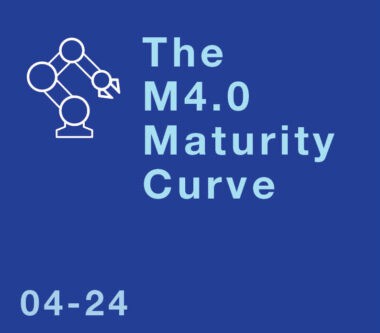Ascending from Pilots to Manufacturing 4.0 Maturity

Tips for selecting, optimizing, and scaling digitalization initiatives across the enterprise

TAKEAWAYS:
● Manufacturers need to carefully evaluate compatibility, scalability, and trustworthiness when selecting digital solutions.
● Prioritizing effective digital transformation investments and executive support is crucial in this evolving landscape.
● Establishing a unified strategy owner can increase successful implementation and progress across the enterprise.
Personnel at all levels of manufacturing organizations are being tasked with “getting on board with the future,” often with little direction on what that really means and without a digital transformation leader providing a strategy or roadmap. As a result, lofty digitalization goals that begin as small-scale pilots may stall when gaps in understanding or planning exist, even if they yield great returns in isolation.
Aspirations for widespread Manufacturing 4.0 adoption are best served when there is clarity on where, when, and how to make technology investments as well as the larger implications on implementation, scalability, organizational change, and culture change. It is especially important in today’s environment of fast-moving and dynamically evolving innovations that are different from anything historically available to the industry.
Navigating Countless Technology Options
Myriad available software and technology solutions, at varying levels of maturity, offer the promise of advancing industrial digitalization goals. Informed consideration of whether a proposed technology initiative will “play nice” with another, deliver value, and scale adequately is necessary when choosing to make technology investments to optimize production and manufacturing performance.
Complicating matters are the newness of the digitalization market and the prevalence of:
- Niche technology providers: A multitude of niche players are still trying to determine where they fit in the larger market. This increases the burden on manufacturers trying to define what they need, who offers the solution, and how they can make it work with the technologies and digital infrastructure already in place.
- Venture capital startups: Very small startup companies often launch small-scale projects knowing they cannot, on their own, scale their business to develop at the rate their customers require. With a professional website, logo, and marketing material, they may appear to be a big player when they actually have few employees and customers. This does not make them irrelevant as they may have a solid vision of a wonderful product, but behind the scenes they are courting established solution providers for help penetrating the market, and some are fundamentally hoping to get bought out.
- Marketing ambiguity: Many digital solution providers present a general idea of the space they are in and the markets they serve, but their web pages and literature are not especially clear on what exactly they do and the solutions they provide. There may be talk of an ability to streamline certain processes and deliver some level or timing of ROI, and maybe a vague case study with a customer example, but there is little clarity on what the application actually does or how it works.
- Trust issues: For manufacturers and technology providers alike, it is difficult to know who you are doing business with these days unless you are dealing with an established, reputable company. There are empty promises when planned or in-development capabilities on a product roadmap never come to fruition. There are companies seeking demonstrations purely to validate their messaging or decision making rather than make commitments. And with very small startups, you do not really know what you are going to get or whether the company will be around for the long term.
Who Owns the Digital Transformation Strategy?
With all the complexities at stake, there remains a severe shortage of people who really understand how the puzzle pieces of a digital transformation strategy can fit together. Manufacturers rarely have a holistic internal roadmap or a single strategy owner who understands both information technology (IT) and operational technology (OT).
Granted, it is very common to see CTOs, CIOs, and IT organizations that are very capable and mature from an architecture standpoint. They have tried-and-true methodologies for ensuring their business infrastructure is technologically advanced and on the latest cloud-based platforms. And they have systems integrators or technology specialists providing solid insights related to IT enablement.
“Many manufacturers that have piloted limited initiatives are unsure how to measure success, and how to scale and integrate the solutions to execute on a daily basis.”
The gap in vision and execution, however, is at the factory floor level. There is not a lot of well-tenured expertise in how all the IT and OT pieces fit together within the rank and file of manufacturers, nor in the industry at large.
For instance, every original equipment manufacturer (OEM) has some sort of connected platform. There are third-party Industrial Internet of Things (IIoT) providers offering strategic solutions, such as sensor-based machine health monitoring and analytics from Advanced Technology Services (ATS). And there are different supervisory control and data acquisition (SCADA) platforms, data historians, and other enterprise resource planning (ERP) and enterprise asset management (EAM/CMMS) plugins. Whether and how these solutions are connected will impact asset reliability and operational performance.
Consequences In Change Management
When faced with an overwhelming disconnect in knowledge and lack of leadership on the strategy, manufacturers have difficulty seeing the big-picture vision and do not know how to make all the transformational technologies and processes work harmoniously. Consequently, many manufacturers that have piloted limited initiatives are unsure how to measure success, and how to scale and integrate the solutions to execute on a daily basis. Despite the hints of potential value, the lost progress and addition of manual work contribute to resistance to change.
How to Right the Ship
Since the root of the challenge is the lack of tenured understanding when it comes to digital transformation technology, it is critically important to have someone at an enterprise level leading the strategy who:
- understands the underlying architecture for the OT side of the business,
- knows how M4.0 digitalization and the IIoT fit into the overall operation,
- is open to new and different offerings and non-traditional ways of doing business,
- can decipher and assess prospective platforms and technologies, including smaller, newly built, and potentially insecure solutions,
- can articulate to stakeholders what the solution does, why it is needed, how it interrelates with existing solutions, and where it falls on the company’s roadmap to digital transformation, and
- is capable of merging the IT and OT technology pieces while ensuring the security protocols are what they need to be.
This individual and their assessment process for what is deployed to the factory floor is crucial to advancing beyond discrete pilot tests to M4.0 maturity. They can prioritize scalable, effective digital transformation investments by establishing where the real opportunities lie, developing a business case, understanding the budget and the return expected from the solution, and determining which vendor(s) can deliver on the goal.
Fortunately, gaining executive support is less of a challenge today. Not long ago, the earliest drivers and adopters of advanced technologies were often forward-thinking engineers. That has since shifted with the C-suite now focusing on digital transformation as a competitive advantage. Increasingly, technology enhancements are pre-approved, in the budget, and part of the plan. What may be lacking is executive direction unless there is someone bridging the knowledge gap between the factory floor and the executive office.
How Partners Can Help
When expertise is lacking in house, being open to partnering with strategic technology and service providers can turn the tide in digital transformation success. Instead of making a “build versus buy” decision, a bit of both is needed. Ultimately, any technology enhancements must live within an infrastructure that suits your enterprise integration, security, and data attribute requirements.
Expert technology and service providers can help facilitate digital transformation planning and close knowledge gaps. ATS does this by bringing their solutioning specialists to even the earliest customer engagements. Being on the front line allows them to better extract customer requirements, articulate new solutions that will work with existing solutions, anticipate future needs, and prioritize the integration of capabilities from a product management standpoint. They can also coach customers through what the potential could be and how you might work together.
“The earliest drivers of advanced technologies were often forward-thinking engineers. That has since shifted with the C-suite now focusing on digital transformation.”
Partnering can also lead to the service provider extending the value of existing customer investments. Incorporating a customer’s small-scale successes into the provider’s larger digitalization solution makes them scalable across the enterprise.
An example is predictive maintenance, which is the proven strategy for improving uptime by detecting and correcting degrading asset conditions before failure occurs. In one use case, ATS helped protect a packaging manufacturer’s plant maintenance team from being overwhelmed by massive and growing volumes of data by automating the collection of machine sensor data and centralizing it for expert analysis and prescriptive recommendations. This allowed the manufacturer to meet reliability and performance objectives more efficiently and effectively.
Finally, it is important to remember that there is no magic bullet in digital transformation. In this example, automating data gathering and analysis does not replace maintenance best practices or standard work. If nobody acknowledges the alert of impending failure or executes the recommended actions, the asset will still fail. Make sure that processes for planning and scheduling corrective actions and closing the loop afterward continue to be followed. M
About the Author:

Micah Statler is Director of Industrial Technologies at Advanced Technology Services.